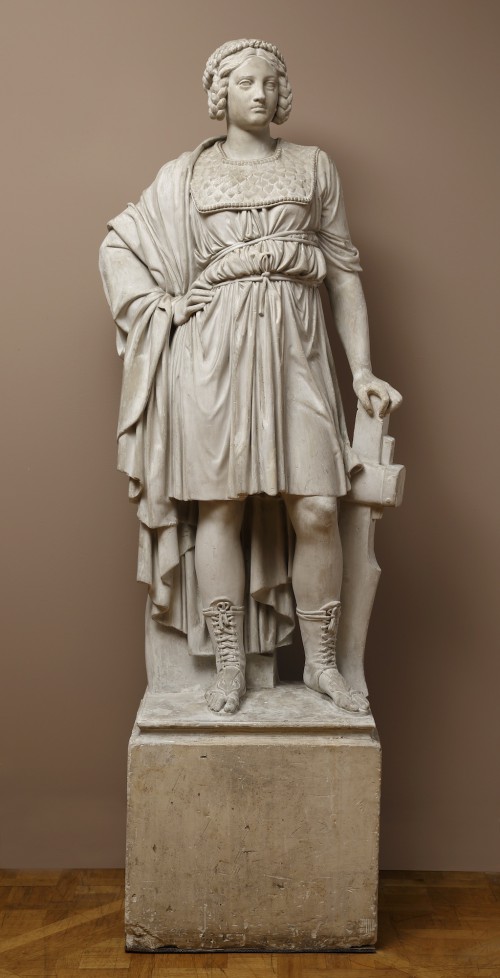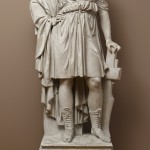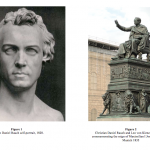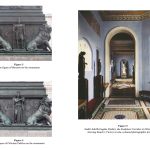11134 A LIFE-SIZE STUCCO SCULPTURE OF ‘BAVARIA’ BY GEBRÜDER MICHELI AFTER A MODEL BY CHRISTIAN DANIEL RAUCH Berlin. Nineteenth Century. Measurements: Height: 83.4” (212 cm) [Plinth: Height: 21.4” (54.5 cm).] Width: 23.2” (59 cm). Depth:18.7” (47.5 cm).

Research
Of stucco, on a square plinth.
Marks:
Signed on back on plinth:
Ch Rauch Fec
Gebruder Micheli Berlin
Christian Daniel Rauch (1777-1857) was the pre-eminent German sculptor of the nineteenth century (figure 1) and an associate of Antonio Canova and Bertel Thorvaldsen, both of whom he met whilst undertaking his training in Rome in the 1810s. Throughout the entirety of his career he received sustained support and patronage from German royalty, especially from the kings of Prussia and Bavaria who both encouraged him to collaborate with their court architects, Karl Friedrich Schinkel (1781-1841) and Leo von Klenze (1784-1864,) respectively.
The present plaster cast is a copy of a figure conceived as part of one of the collaborations with von Klenze, undertaken in 1835, an elaborate architectural and sculptural monument commemorating the reign of Maximilian I Joseph of Bavaria (1756-1825), which remains outside the Residenz in Munich to this day (figure 2).1 The figure is a female personification of the Bavarian nation, and appeared on the plinth of the monument; while her clothing is Neoclassical, her hairstyle is presented in a traditionally Bavarian fashion. In a symbol of the agricultural productiveness of the kingdom, she rests on a ploughshare, the cutting edge used on a plough (figure 3). This figure was designed as a partner to another female figure situated on the other side of the plinth, Felicitas Publica or Public Happiness, who bears a cornucopia, a symbol of plenty (figure 4).2
Rauch’s popularity spread far and wide; Queen Victoria and Prince Albert both who were discerning collectors of sculpture, met him and acquired pieces of his work. The Queen purchased a Winged Victory by the sculptor at the Great Exhibition of 1851 for £371 to give as a gift to the Prince, which remains to this day prominently placed in the Sculpture Corridor at Osborne House (figure 5).3 Even after the Crystal Palace had decamped to Sydenham, the work of Rauch remained much in evidence. He was the most represented sculptor there, with nineteen of his works on display.4 The above mentioned Winged Victory was after an original from a group of six commissioned from Rauch by the King of Bavaria, Ludwig I for his most extraordinary architectural project, the Walhalla outside of Regensburg, which was designed to contain busts and sculptures of the most famous and accomplished personalities in German history. Rauch spent much of the 1830s working on sculptures for this project at the same time as he was composing the present figure for the above-mentioned monument, also commissioned by Ludwig I.
The present plaster version bears the inscription on its reverse ‘Ch Rauch Fec, Gebrüder Micheli Berlin’. Gipsgießerei Micheli was was founded in 1824 in Berlin, presumably taken on later by the two brothers, Claudio (dates?) and Aurelio (1837-1908) Micheli, who were both also recorded independently as sculptors. The latter was noted in the Verzeichnis lebender Künstler welche in den Sälen des könighl. Akademie-Gebäudes zuBerlin 1866 ausgestellt sind. The company completed both original works as well as copies of busts and sculptures by notable artists such as “Christian Daniel Rauch, Antonio Canova, Berthes Thorvaldsen, Fritz Schaper, Reinold Begas and numerous others.”5 They were regular contributors to the great world fairs of the mid and later nineteenth century, for example showing “plaster of paris and marble work” at the London 1862 International Exhibition, where they won a medal.6 Another example of a Micheli copy of a work by Rauch is a bust of Johann Wolfgang von Goethe at Frankfurt University.7
Footnotes:
- Jutta von Simson, Christian Daniel Rauch, Berlin 1996, p. 239
- Ibid.
- Jonathan Marsden ed., Victoria and Albert: Art and Love, Ex. Cat., Queen’s Gallery London 2010, p. 154
- Ibid.
- http://spinoza.blogse.nl/log/aurelio-micheli-1834-1908-maakte-een-gipsen-spinoza-buste.html
- Official Catalogue of the Industrial Department, London 1862, p. 271
- https://www.uni-frankfurt.de/39022326/rauch-goethe-bueste



Comments are closed.